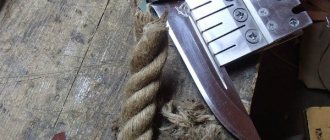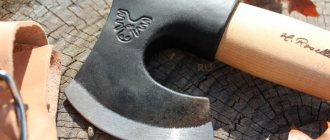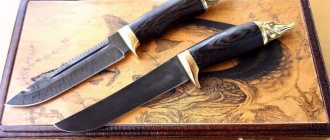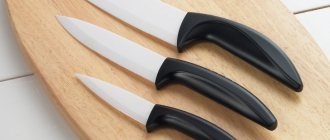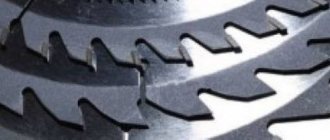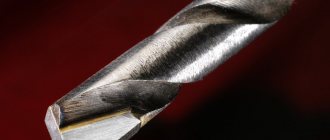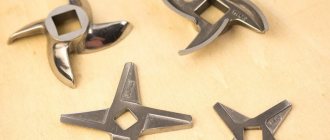Why does the knife get dull?
Sharp objects are dangerous because you can get hurt when using them. But even more trouble will come from a dull chef's knife, which can slip and easily injure your hands.
The blades sold in the store are sharp and easy to work with. But their shelf life depends on operating conditions.
Following a number of recommendations will help keep your kitchen knife sharp longer:
- during storage, the cutting edge should not touch surfaces that have a high density;
- cutting should take place on special boards made of wood or plastic;
- blades of all types must be used for their intended purpose, avoiding shock loads on blades whose sharpening has a small degree;
- Immediately after use, knives should be washed and dried.
The sharpness of the cutting edge decreases for several reasons:
- Impact of organic acids contained in products on the blade material.
- Impacts from a fall.
- Cutting on hard surfaces such as stone countertops or ceramic cookware.
- Uneven load on the cutting blade when the composition of the products is uneven (the blade hits bones, tendons when cutting meat).
- Exposure to aggressive chemicals and high temperatures during cleaning.
- Improper use.
If the knife is intended for cutting the fillet of fish, then when opening cans with it, the blade will be damaged. The nature of the RK violations depends on the material from which the blade is made.
Knives made of stainless steel are resistant to aggressive environments, but without proper care, rust appears on the surface of the blade. Such blades are easy to sharpen, but this process must be carried out more often.
Carbon steel has increased strength, such blades are more difficult to sharpen, but they retain their sharpness longer. With insufficient care, the metal quickly becomes covered with rust.
By combining hard and soft steel in industrial production, alloys are created that imitate the blacksmith forging inherent in Damascus blades. Knives are made primarily for hunters using this method.
Products made from zirconium alloy are characterized by increased fragility. These ceramic knives are designed for smooth, soft products and keep their blade sharp for a long time. A special tool is required for sharpening.
Calculate the angle of descent on the knife.
Do-it-yourself blade sharpening
Sharpening with a whetstone
Sharpening a blade with a whetstone is the most reliable method available to anyone. After all, not everyone has the opportunity to use a professional machine.
To sharpen the blade, perform the following steps:
- Fix the whetstone with a fine-grained surface in a vice or other way.
- Holding the blade at an angle of 20–25 degrees relative to the surface of the whetstone, begin to move the blade along the block with the cutting edge.
- The blade is moved so that it touches the block with its entire plane.
- Movements are carried out at the same angle of inclination of the blade.
- After 2-3 passes, turn the knife over and repeat the same steps on the other side of the blade. Sharpen until an edge (burr) appears.
- The fine-grained stone is replaced with a coarse-grained one and the blade is ground until the edge disappears.
- To check a sharpened knife, cut a rope or sheet of paper several times.
Sharpening with a Lansky sharpener
The work is performed in this order:
- Clamp the blade in a vice.
- A sharpening stone with a fine-grained abrasive is installed on the rod.
- The angle of inclination of the bar is set within 20–30 degrees.
- Install the rod into the hole.
- Lubricate the block with technical oil (it is included in the Lansky kit).
- Treat the blade with a whetstone - from the base to the tip of the blade.
- Turn the sharpener over. Repeat the above process on the other side of the blade.
- After the edge appears, change the block and perform finishing grinding.
- Polish the blade with felt.
Sharpening a knife with improvised means
You can sharpen a blade without special devices, using available tools:
- Stone. You can sharpen a knife with a stone in any conditions. Simply pick up a stone and use it as a whetstone. It will not be possible to achieve ideal sharpness, but the blade will be in working condition.
- Second knife. In this case, they do without any devices at all. They take a knife in both hands and sharpen them against each other. 5-10 minutes are enough for the blades to become much sharper.
- Glass. The blade is sharpened by running it along the rough (rough) edge of a glass or ceramic product.
- Leather belt. Leather is usually used for finishing sharpening. But if you have no choice, you can use a leather belt as your only sharpening device. The belt is tightened, and then they begin to move the blade along it. After several minutes of such manipulations, the blade will become sharp.
Peculiarities of sharpening some types of steel
Hunters value knives made of Damascus steel or damask steel. Products made from these metals require a non-standard approach to sharpening. They cannot be processed on a sharpening machine. The reason is that Damascus steel is an alloy of hard and soft grades of metal. In order not to spoil the product, it is sharpened by hand. Before sharpening, the strength of the metal is checked: the sharper the edge, the harder the steel. A Damascus blade is sharpened exclusively along the blade, using a sharpening stone with fine grains. Gradually switch to “velvet” sandpaper.
The damask blade is sharpened using a wet sharpening stone. First, coarse-grained whetstone is used. The process is completed by processing the metal with a bar with fine grains. The final finishing is carried out on ceramics.
A quality hunting knife is an expensive item. A good hunter takes care of his weapon and is proud of it. You should not unnecessarily test its strength (for example, try to cut a carcass with a dull knife). Also, do not leave the blade in the ground, put it in boiling water, or open cans with a knife. After use, the knife should be cleaned, because otherwise the blade will oxidize and rust.
Knife device
Any knife consists of a metal or ceramic strip and a handle, which is made of wood, plastic, ceramics or other materials. Depending on the way the handle and blade are articulated, knives can be fixed, folding or detachable. The handle can also be positioned perpendicular to the cutting blade.
The blade has a RC formed by two or one microfeed. Depending on the shape of the perpendicular section, the cutting edge can be formed by a bevel without microfeed.
The part of the blade opposite to the RK is called the butt. It can also have a sharpening, as in the case of a double-edged knife. The section of the blade that is adjacent to the handle and has no sharpening is called the heel.
How to sharpen a hunting knife correctly?
You can use a variety of tools to sharpen hunting knives. So, usually knife manufacturing companies offer to purchase an additional special sharpener when purchasing. Often, special sheaths for hunting knives have convenient compartments for storing such sharpening devices. In field conditions, mechanical pocket sharpeners are the best choice. They come in a variety of sizes and shapes, but are always made from only the best materials so that you can restore the sharpness of your instrument with just a few simple movements.
If we talk about the shape of sharpeners from manufacturing companies, they can have the shape of round, light rods, up to 15 centimeters long and several centimeters in diameter. Such devices are housed in protective plastic cases and also have fastening elements that allow the sharpeners to be placed on a hunter’s belt or in a sheath. Tools of the same type can also have the form of plates. The material for the manufacture of cylindrical devices is ceramics, flat ones are made of diamond abrasive.
Pocket sharpeners from the manufacturer can also be a small tool of a round, rectangular or oval (with smoothed corners) shape that fits in the palm of your hand. In them, miniature plates of carbide or ceramic stones are located at an angle specified for sharpening in special recesses made in a plastic case.
The greatest effect can be achieved if you take advantage of manufacturers' offers and buy a knife sharpener case. It will help sharpen a hunting knife on a clamp with numbered sharpening angles, using whetstones of different colors, each of which indicates the size of the abrasive grains.
The additionally supplied special oil allows you to achieve perfect sharpening sharpness. This set of sharpeners is not pocket-sized. It is perfect for teaching beginners, and you can start using sharpeners by sharpening, for example, kitchen knives, and gradually master sharpening any cutting tools.
It should be noted that pocket sharpeners are the best choice directly for hunting, but thorough preparation of the tool for it should be done at home.
Shapes and sharpening angles
Depending on the purpose of the knife, there are several blade cross-section shapes:
- Scandinavian, when the descent connects the butt with the RK and the cross-section has a wedge-shaped shape. A small angle is convenient for cutting, but does not withstand impact loads well.
- Scandi - the RK angle is more obtuse than in the first case. It withstands shock loads better, but cuts worse.
- Razor, when the slopes have a concave shape, which provides a small angle for the cutting edge and ensures high cutting quality. This sharpening is used for straight razors. It is not recommended to subject the blade to shock loads.
- Lenticular - the descents are curved, while the angle of the RK is of greater importance. This cross-section is typical for axes intended for chopping.
- One-sided - the descent is designed on only one side of the blade. This type is typical for carpentry tools and knives made in Japan.
- European - a wedge-shaped descent from the end turns into a micro-approach at the edge. This cross-sectional shape of the blade provides an increased angle compared to the Scandinavian cross-sectional shape, due to which the blade better tolerates shock loads, allowing chopping movements.
Electric knife sharpener.
Table of values for different knives
A table is used to determine the optimal sharpening angle.
| Knife type | RK sharpening angle in degrees |
| Kitchen | 55-60 |
| Chef | 25-30 |
| For fish | 25 |
| For fillet meat | 10-15 |
| For cutting and deboning | 25-30 |
| For frozen fish and meat products | 35-45 |
| Vegetable | 35 |
| Japanese | 15-18 |
| Special | 40 |
| Folding | 20-25 |
| Tourist for cutting | 30-35 |
| Tourist for cutting | 40-45 |
| Hunting | 40-45 |
| For cutting | 25-30 |
| Shoe | 30-40 |
| For cutting | 20-25 |
| Straight razor | 10-15 |
Varieties of sharpening angles
There is no single correct cutting edge angle. It all depends on how the knife is used.
The general principle is this: the smaller the sharpening angle, the sharper the blade and, accordingly, the better cutting properties it has. The downside is a noticeable decrease in the thickness of the metal, which greatly weakens the strength of the blade. This especially affects impact resistance.
And vice versa. A larger sharpening angle can significantly strengthen the blade. By the way, if you sharpen the cutting edge at an angle of 50 degrees, then such a blade will be able to cut a nail with a diameter of 5 mm. But cutting ordinary food products with such a knife will turn into a living hell. So what angles are considered optimal for a particular activity?
This question was once seriously asked by the global standardization company CATRA. According to the classification she developed, there is a table of knife sharpening angles based on their application:
But is it only the angle of the cutting edge that determines the performance properties of a knife?
Methods for determining the sharpening angle
Having bought a new kitchen knife with a good sharpening, it is advisable to immediately measure the angle of the angle of rotation in order to adhere to this value in the future. If you do not have a special device, you can use scissors with long cutting ends.
The knife rests with the RK at the point where the blades diverge, then they are closed until the gap near the microfeed disappears. The angle of spread of the scissors projected onto the paper is measured using a protractor.
You can also use a soft candle to determine the sharpening angle of the blade. To do this, a layer of softened paraffin is applied to the side edge of an oiled wooden stand. The tip is inserted into it in one motion and held in this position until the soft mass hardens. The resulting print is photographed, and the required angle of the RK is determined using a protractor.
Sharpening instructions.
Making the optimal angle on the mat
If you are sharpening a knife using musat, the optimal angle would be 25 degrees.
Sharpening work is carried out as follows:
- Take the musat in one hand and rest its end against a hard and flat surface. Make sure that the device does not slip during the process.
- In your other hand, take a knife whose sharpness has decreased.
- Place the cutting edge of the kitchen tool against the rod at an angle of 25 degrees.
- Perform 4-6 movements with the knife along the musat away from you and towards you, while simultaneously turning the blade.
If the musat has a diamond coating, then to restore the sharpness of the knife blade it is enough to run it along the rod once.
Experts warn that this device is not capable of fully sharpening a blade; it is only used for editing.
We suggest you read How to assemble a car seat after washing
Angle Holding Devices
The correct sharpening angle of the cutting edge of the blade will help to hold the device in which the knife is fixedly fixed at the required angle to the abrasive surface moving across the wheel.
The blade can also be processed on a machine designed for sharpening. But the high speed of the abrasive wheel increases the likelihood of errors when working with a beginner. Fixed blade tools must be adjusted by a professional.
Electric devices for sharpening the RK do not require special skills and allow you to set values on the sharpener in the range from 15 to 30°.
Accessories and tools
The following devices are used for sharpening cutting tools:
- Sharpening whetstone: allows for high-quality sharpening using coarse-grained whetstone. It is small in size and allows you to maintain the angle of the knife while sharpening. The tool is turned on both sides.
- Musat: a device in the shape of a round file. It is used primarily when turning knives with small deformations. The object to be sharpened is applied to the grinder. To sharpen, you need to run the blade over the tool 4 to 6 times.
- Grinding machine: consists of an electric motor and rotating wheels made of abrasive metals. It is actively used in professional fields and requires a person to have knowledge of turning skills. Otherwise, the steel may become very hot, which will have a negative impact on the strength of the blade.
For sharpening, improvised means are also used: stone sharpeners, glass, leather belts. With the help of these sharpening devices, you can not only restore the sharpness of a cutting object, but also give it additional shine.
Electric sharpening is used to sharpen knives at different angles. It consists of abrasive discs and an electric drive. The rotation of the sharpening structures is carried out autonomously, which facilitates the work process.
Grinding the knife after sharpening
After processing the blade, it is recommended to grind it using a block or other abrasive. Then, to obtain an optimal result, it is recommended to continue polishing with a fine-grained material. A leather belt works well for this purpose.
The belt secured on one side is lubricated with goyi paste and pulled by hand through the loop at the other end. Polishing and finishing are done with the butt forward, alternately on each side, gradually reducing the pressure on the belt. Grinding is considered complete when the blade surface is brought to a mirror shine. This method can be used to edit both a shoemaker's knife and a folding knife.
Use of whetstone
During operation, the touchstone inevitably becomes contaminated. The pores of the working surface become clogged with metal dust and the remains of crumbled abrasive grains.
In order to clean the bar, you should immerse it in a warm soapy solution for 15-20 minutes. Some craftsmen simply rub the whetstone with laundry soap.
After soaking, the block is washed with plenty of water, while scrubbing with a stiff brush.
If you have an ultrasonic washing machine at hand, then place the bar in a container with a warm soapy solution, lower the ultrasonic emitter into it and leave it for 5 minutes. High-frequency vibrations remove all contaminants from the pores of the working surface.
Touchstone is used in all areas of human activity. Wherever there is a cutting metal tool or household item, it must be sharpened.
I use the whetstone at home to sharpen knives. Fine-grained whetstones are used to sharpen blades to extreme sharpness. Touchstones are also used in agriculture - they are used to sharpen scythes and axes. In the garden, abrasive stones are used for lawn mower blades.
If you find an error, please highlight a piece of text and press Ctrl Enter.
Features of Japanese models
The Japanese knife has a one-sided sharpening at an angle of 15-18° and looks like a French chef's knife. The wide blade and the downward tip of the blade on the side of the butt allow you to make movements when cutting only up and down, without swinging. Skill is required to operate this tool.
Sharpening of knives for Japanese cuisine is done only by hand using a water stone. Magnetic blades do not require sharpening because they have a self-healing structure.
Previous
KnivesKnife handle material G10
Next
Kitchen knivesHow to store knives in the kitchen
Sharpening stones for machine tools
When using water stones, irregularities form on their surface, which impairs the quality of sharpening knives and other cutting tools; you can correct them:
- sandpaper;
- silicon carbide powder;
- sand;
- diamond block.
But it is easier and faster to sharpen the sharpening tool with special stones - synthetic water stones with diagonal cuts along the surface of the same depth. They can be hand-held or tabletop. In the first case, straightening is carried out with a stone with cuts, in the second, the damaged whetstone is ground/straightened on a fixed one.
The most popular stones for dressing water stones:
| Name | Description | Photo |
| Table stone from the Large series NANIWA Flattening Stone for Sharpening Stones (Truing Stone) | It has the same grain size (24 grit) and is made of silicon carbide. | |
| Table stones from the JUUMA Flattening Stones series | Made from aluminum oxide, they are a series of four stones of different grain sizes. It is noteworthy that they are able to rule even each other. | |
| Suehiro Hand Stones | They have a medium grain size (200 grit), are intended for straightening synthetic water stones, correcting both subtle unevenness and deep “pits” and grooves. |
